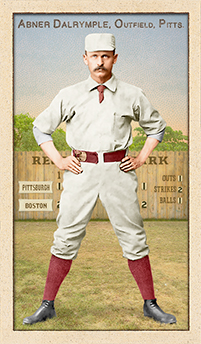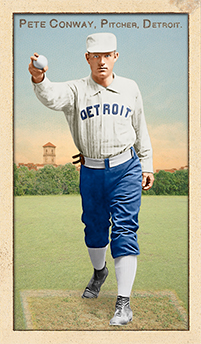
- Series: Beginnings: 1880's
- City: Detroit
- Team: Wolverines
- League: National League
Peter J. Conway (1866-1903) was a tough right-hander who played in tough luck with his early major-league clubs. Both the Buffalo Bisons and Kansas City Cowboys struggled to seventh-place finishes and failed to support their youngster during the 1885-86 seasons. He came into his own with a much better Detroit Wolverine squad for three years, helping the club win the pennant and post-season tourney in ‘87. Pete’s best year was in ‘88, going 30-14. The Wolverine franchise and Conway’s arm gave out. Pete went to the Alleghenys but got into only three games. Pressures were building that would culminate in the Players’ League “revolt” and the cavalier treatment Conway received in Pittsburgh was widely seen as all-too-typical. Pete tried unsuccessfully to play for Ward’s Wonders in 1890 but the arm was gone.
- In 1891 Conway was hired as the first head coach of the other Wolverines: those of the University of Michigan
- Series: Beginnings: 1880's
- City: Pittsburgh
- Team: Alleghenys
- League: National League
Abner Dalrymple (1857-1939) was one of the most prolific hitters of the fledgling NL. He was the leadoff batter for 8 straight years (with 5 pennants) for the Chicago White Stockings, contributing to a team home run record in 1884 that stood until eclipsed by the ’27 Bronx Bombers. He hit over .300 six times.
- Still shares a record for 4 doubles in 4 at-bats, July 3, 1883
- A.G. Spalding paid $2500 (!) to get Dalrymple from the Milwaukee Grays in 1878
- Dalrymple earned that confidence, winning the NL batting title in his rookie year
- In 1881 became first ever batter to be intentionally walked with bases loaded
- Dalrymple's uniform color in this card was changed from blue to red in August, 2017 to reflect recent reliable research conducted by Craig Brown and friends at Threads of Our Game. Two cards were previously released featuring a blue uniform
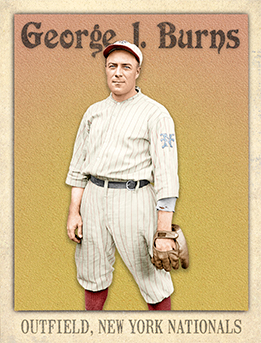
- Series: Diamond Heads '15
- City: New York
- Team: Giants
- League: National League
George Joseph Burns (1889-1966) was dubbed by his teammates “Silent George” for his reserved, soft-spoken manner. He might as well have been named “Anonymous George” as one of the greatest outfielders of his generation of whom few remember today. He retired holding records for leading the National League in runs scored five times, a Giants' club single-season record for steals (62) that still stands, and top-ten ranking in games played and games in the outfield in MLB. The Utica native debuted with McGraw's crew in 1911 and George quickly found a home in left at the Polo Grounds, mastering its odd angles and even conquering the dazzling afternoon glares, prompting scribes to dub the area Burnsville. He was one of the first to don sunglasses and his mates later described him as “the 'greatest sun fielder' in the history of the game.” Only Rogers Hornsby exceeded George's total bases in 1917 and it wasn't till Willie Mays 53 years later in 1972 that his career stolen base record for the Giants would be eclipsed. His last hurrah in NY was the 1921 Series. The team hadn't won in October since 1905 and George hadn't performed well in his previous attempts at post-season glory. But '21 proved triumphant for Burns and his team as they beat the Yankees in the first Series between teams sharing the same home field. Babe Ruth had been phenomenal in the regular season but was hurt during the post-season and George got to wear the laurel wreath.
- A renowned amateur boxer and wrestler, the diminutive Burns never backed down from invitations to grapple with his much more physically formidable teammate Jim Thorpe
- Growing up in his father's pool hall, Burns was a world-class pool player, but teammates wouldn't play with him unless he agreed to play left-handed
- McGraw traded Burns to the Reds two months after the '21 World Series for Heinie Groh, but the speedy Burns wasn't through. He set an NL record with his 28th steal of home in 1922
- In fifteen ML seasons, Burns' 2,077 hits produced a .287 career average and only Musial and Hornsby equaled his feat of leading the NL five-times in runs record
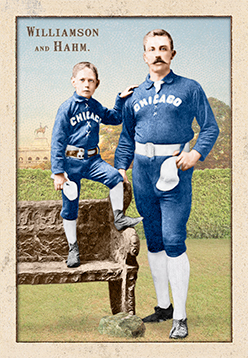
- Series: 1880s: Diamond Duos
- City: Chicago
- Team: White Stockings
- League: National League
Ned Williamson:
Edward Nagle Williamson (1857-1894). A 3rd baseman & shortstop for 3 teams over 13 seasons, Ned was an above average hitter & excellent defender (despite his portly physique). Ned held the single season HR record (27 in ’84) until topped by Ruth’s 29 in ’19. Ned’s career was shortened by a knee injury he sustained while participating in Al Spalding’s baseball world tour.
In 1894, the Reach Guide convened a panel of 11 former ballplayers, including HOFer Jim O'Rourke, to debate who was the greatest baseball player of all time. The panel concluded that the honor belonged to Ned Williamson. Cap Anson himself called Ned "the greatest all-around ballplayer the country ever saw."
- Won 5 NL pennants
- Played in two World Series
- Once owned single season doubles record: 49
Willie Hahm:
Willie Hahm, also known as “Master Willies,” was a rarity among early baseball mascots. He was white. The youngster, said to have been barely able to talk when first brought to the dugout, was the diminutive talisman for the Chicago White Stockings in the mid-1880s. “The Chicagos have great confidence in him as a promoter of success and make a great fuss over him” said Louisville Colonels manager Jim Hart in one of the earliest interviews explicating the curious role of mascots in America’s game. After triumphing in the 1884 campaign, Hart said the Sox had paraded Hahm at the head of their procession in an open landau. The Chicago Tribune reported on a big match with the rival Wolverines on June 18, 1886. Al Spalding brought a trainload of boosters to Detroit in hopes of preventing the eclipse of Chicago’s record home winning streak. Downtown Motor City was treated to the spectacle of the White Stockings and 200 rabid fans marching from the depot to the Russell Hotel carrying broomsticks with Willie Hahm leading the throng. Later, per the Tribune, “The Chicagos were escorted to the ground by a band, and entered the field behind little Willie Hahm, who carried an immense broom on which were written the words Our Mascot.”
- Many of the early mascots were black kids dragooned by superstitious players such as NY’s Buck Ewing
Artist's Note:
- The uniform colors on this card were changed in April, 2017 from black to blue to reflect recent reliable research by Craig Brown & friends at Threads of Our Game. Two cards were previously released featuring black uniforms.
Auction History
Cartophilia
Old Judge Pose: 502-7
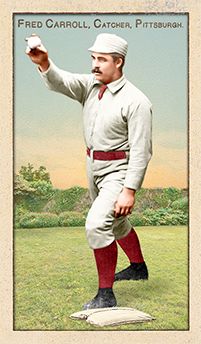
- Series: Beginnings: 1880's
- City: Pittsburgh
- Team: Alleghenys
- League: National League
Frederick Herbert Carroll (1864-1904) was born in Sacramento and, per Bill James, never really adjusted to life in the East. James touts Carroll as perhaps the finest “young” catcher, not only of his era, but until the arrival of Johnny Bench. Fred was nineteen when he started for the Columbus Buckeyes of the American Association. He moved on to spend seven more years in MLB for three Pittsburgh franchises in the AA, NL and Players' League. During this fairly brief tenure, Carroll twice hit over .300 and twice was among the league leaders in home runs. His career average of .284 justifies James' assessment of the rare hitter with power at catcher. Hall of Famer Buck Ewing set the standard for 19th century catchers, but Carroll was as solid as they come. Carroll had quite a year in 1886 with the Alleghenys. He set career marks in hits, doubles, triples and runs. And he also faced a club suspension for fighting teammate Otto Schomberg. Team owners, perhaps realizing how disliked Schomberg was, quickly ended Carroll's exile and lowered his fine to $50. The following season Fred became the first Pittsburgh player to hit for the cycle.
- In 1889 Carroll led the league in on-base percentage and slugging, said by the Encyclopedia of Baseball Catchers to be a record production for a catcher of that age (24)
- Carroll left the Steel City for his home state, playing for Oakland and SF in the minors
- Carroll's uniform color on this card was changed in February, 2017 from blue to red to reflect recent reliable research by Craig Brown & friends at Threads of Our Game. One card had been previously released featuring a blue uniform.

